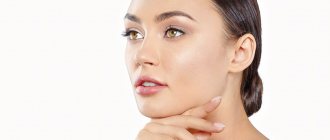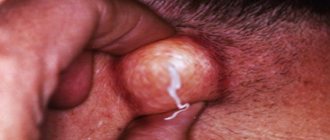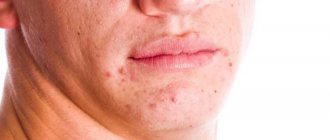Estrogen
It is rightly called the hormone of beauty and femininity. Maintaining adequate estrogen levels is important because it provides the following134:
- stimulation of hyaluronic acid production, maintaining a sufficient level of skin moisture;
- elasticity, beauty and strength of nails and hair;
- active regeneration processes;
- collagen synthesis;
- maintaining skin metabolism.
If there is a lack of estrogen in the body, hormone replacement therapy may be prescribed.
Lack of somatotropin
Somatotropin is a growth hormone, an insulin antagonist in its effect on carbohydrate metabolism. If there is a deficiency, it is advisable to use a product with the following composition124:
- Proxilan, Asian centella extract. These ingredients help smooth the skin and regenerate epithelial cells.
- Shea butter. Cell renewal is stimulated, providing a slight lifting effect.
- Extracts of flax, soybean, kombucha, hyaluronic acid, biolipids. They launch internal self-healing processes.
Somatotropin is found in red and white fish, legumes, and lean meats.
Progesterone
It is an antagonist of sex hormones. When acne appears due to hormonal imbalance in women, progesterone levels are checked. If it is low, this explains the rash. But too high its concentration in the body also leads to negative consequences134:
- swelling due to fluid retention in the body;
- hyperpigmentation;
- decreased firmness and elasticity of the skin.
To normalize progesterone levels in the body, in addition to hormonal therapy, you may also need to adjust your diet. The diet should be rich in foods rich in magnesium, vitamin B6, zinc, and ascorbic acid.
Modern diagnostics
To identify a hormonal deficiency of male hormones, the attending andrologist or endocrinologist carefully collects anamnesis. Pays attention to the general state of health, assesses the state of memory, ability to concentrate, etc. To detect pathologies of the endocrine system, the patient is referred for an ultrasound scan of the prostate, pituitary gland, and thyroid gland. The level of total testosterone, the concentration of TSH, estradiol, prolactin, SHBG and other hormones are checked in the blood.
In men, the condition of the cardiovascular system is checked - the lipid profile is assessed, an ECG and ultrasound of the blood vessels are performed. To detect pathology of the musculoskeletal system, the patient undergoes x-rays of either the bones or the spine. The diagnosis is made only after a comprehensive diagnosis has been carried out.
Androgens
Most often, when mentioning cases of acne on the face due to hormonal imbalance, we are talking about hyperandrogenism. Androgens are called male sex hormones or sex steroids. Testosterone (one of the androgens) is present in both male and female bodies. This hormone is responsible for the following134:
- skin density;
- stimulation of collagen synthesis, responsible for skin elasticity;
- accelerating the process of cell renewal;
- activation of sebum production, increasing skin oiliness;
When testosterone levels are high, hair growth occurs on the body and face. The concentration of androgens increases towards the end of the menstrual cycle, so it is on these days that acne may worsen.
How does acne form?
Acne is a disease of the follicles. During this disease, very strong production of sebum occurs, the formation of rashes and biofilms, the formation of colonies and the appearance of inflammation on the skin. The first and most obvious symptom of the disease is the appearance of microcomedones. It has not yet been precisely established by what principle they are formed.
In those people who are predisposed to acne, the sebaceous glands are large. They begin to form in adolescence. The following types of hormones are involved in the formation of acne:
- androgens
This type of hormone is one of the most important for the secretion of sebum in our body. During the period of growing up, they allow the production of as much sebum as possible, which is the reason why acne appears in adolescents and adults of both sexes.
- estrogens
High levels of these hormones negatively affect sebum production. The sebaceous glands become smaller. Their increase can even at the genetic level affect the regulation of the sebaceous gland.
- progesterone
This type of hormone converts testosterone into the more powerful hormone DHT.
- insulin and insulin-like growth factor 1
It accelerates the growth of sebaceous gland activity. This has already been proven through numerous studies. It greatly affects the functioning of the adrenal glands.
- corticotropin-releasing factor (CRF)
Thanks to it, accessibility to the sebaceous glands is formed, which are its main purpose.
- adrenocorticotropic hormone (ACTH)
Participates in the formation of large amounts of cortisol.
- melanocortin
Regulates sebocyte differentiation and lipogenesis.
- glucocorticoids
Affect the formation of numerous inflammations.
- a growth hormone
Takes part in the differentiation of sebocytes and increases the rate of conversion of testosterone to DHT.
D-hormone
It will be news to many that vitamin D is both a vitamin and a steroid hormone134. It is mainly synthesized under the influence of UV radiation. Maintaining normal vitamin D levels contributes to the following134:
- epidermis regeneration;
- healing damaged skin;
- production of proteins, elastin, collagen.
A deficiency of vitamin D can be compensated for by eating foods rich in vitamin D and taking medications prescribed by a doctor.
How to treat acne* due to hormonal imbalance?
Acne should be treated by a dermatologist. If a hormonal imbalance is suspected, he may refer the patient to an endocrinologist. The specialist decides what to do in this case, for example, prescribes hormone replacement therapy.
The main therapy for acne is prescribed by a dermatologist. For mild to moderate acne, the doctor may recommend the use of topical antibiotics, for example, Clindovit® gel6,18. It must be applied to cleansed, dry skin6.
Clindovit® gel is recommended for use in combination with benzoyl peroxide or azelaic acid (for example, Azelik® gel) to reduce the risk of developing antibiotic resistance28.
*acne
Introduction
Acne vulgaris affects ~80% of adolescents and young adults aged 11–30 years. In most patients, manifestations subside before the age of 30, while in others an unpredictable course may occur throughout life [1]. The main features of acne include follicular hyperproliferation and congestion, increased sebum production, P. acnes activity, and inflammation [2]. Standardization of acne treatment is not possible due to the huge amount of published data and research [3]. Hormonal therapies are relevant not only for patients with biochemical markers of hyperandrogenism, but also for severe, resistant cases, as well as for patients with an unpredictable course and a high frequency of acne exacerbations without hyperandrogenemia [4]. Understanding a person's hormonal status can lead to optimal, faster, and more appropriate acne treatment.
Pathogenesis of acne
Acne is a disease of the follicle. It includes pathological overproduction of sebum, pathological follicular keratinization, formation of P. acnes biofilms and colonies, and finally the release of proinflammatory mediators in the skin [5]. While the formation of microcomedones is the first symptom of acne, the exact trigger of this reaction remains unknown [6]. People prone to acne have larger sebaceous glands, which are stimulated during puberty [7]. Dihydrotestosterone (DHT) was shown to be more selective for facial rather than leg sebocytes. This determines the propensity for acne to affect certain areas of the body [8]. Several metabolic pathways and hormones other than androgens regulate sebocyte activity, such as peroxisome proliferator-activated receptors, substance P receptors, α-melanocyte-stimulating hormone, insulin-like growth factor, corticotropin-releasing factor (CRF), vitamin D, and ectopeptidases [9]. -eleven]. Meanwhile, overproduction of sebum with proliferation of follicular keratinocytes leads to obstruction of the pilosebaceous unit by sebum and horny masses, resulting in large comedones. As a consequence, follicular units are blocked and bound to pathogenic P. acnes, leading to an exaggerated inflammatory response [12]. P. acnes secretes many factors, including lipase and protease enzymes, which can destroy the follicular wall and trigger a cascade of inflammatory reactions and the release of chemoattractants [13]. An additional area of interest that has recently emerged is the action of vitamin D in the skin. The pilosebaceous unit is capable of metabolizing and producing provitamin D in the skin. Vitamin D deficiency may play a role in the pathogenesis of insulin resistance and metabolic syndrome in polycystic ovary syndrome (PCOS). In addition, vitamin D analogues may potentially be useful in normalizing sebaceous gland physiology in patients with acne [14].
Involvement of hormones in the pathogenesis of acne
Hormones involved in the pathogenesis of acne include androgens, estrogens, progesterone, insulin and insulin-like growth factor 1, corticotropin-releasing factor (CRF), adrenocorticotropic hormone (ACTH), melanocortin, glucocorticoids and growth hormone [15].
Androgens
Androgens appear to be the most important of all hormones regulating sebum production [16]. From puberty, androgens stimulate sebum production and the formation of acne in both sexes. This androgen-dependent sebum secretion is mediated by both powerful androgens, such as testosterone and DHT, and weaker androgens. The adrenal glands and ovaries are the source of production of dehydroepiandrosterone (DHEA) and androstenedione. DHEA is predominantly produced by the adrenal glands, while androstenedione is produced by the ovaries and adrenal glands in equal proportions. Interestingly, 5α-reductase, an enzyme in the infundibulum sebocyte, can convert testosterone to 5-10 times more active DHT [13].
Progesterone
Progesterone inhibits 5α-reductase, which converts testosterone into the more potent DHT. Menstrual flushing and acne flare-ups are caused by progesterone, whose receptors are expressed only in basal epidermal keratinocytes [4].
Estrogen
High doses of estrogen negatively affect the hormonal system. This leads to a reduction in the size of the sebaceous gland and also reduces the production of sebum. Estrogen receptor (ER) α is localized only on sebocytes, while ERβ is found in large quantities on sebocytes, keratinocytes, melanocytes, skin fibroblasts, endothelial cells and adipocytes [17]. Estrogen may influence sebum production by 1) inhibiting the negative effects of the gonads, 2) increasing the production of sex hormone binding globulin (SHBG) by the liver, thereby reducing free serum testosterone, 3) directly counteracting the effects of testosterone in sebocytes, and 4) influencing on the genetic regulation of the sebaceous gland and sebocyte formation [18].
Insulin and insulin-like growth factor
Insulin stimulates the growth and maturation of the sebaceous glands. This action is mediated through insulin upregulation of growth hormone receptors on sebocytes [19]. In addition, insulin inhibits the production of SHBG by the liver and subsequently, through a positive feedback mechanism, affects adrenal and ovarian androgenesis. The controversial relationship between diet and acne may be explained by the fact that foods with a high glycemic index lead to the release of insulin and in turn increase androgens and sebum production [20].
Corticotropin releasing factor
CRF secreted by the hypothalamus is converted to pro-opiomelanocortin in the anterior pituitary gland. Proopiomelanocortin is converted to ACTH and melanocyte-stimulating hormone, which activate cortisol production. The targets of CRF are the sebaceous glands, in which lipogenesis is induced by increasing the bioavailability of androgens and stimulating the conversion of DHEA to testosterone [21].
Melanocortins
Melanocortin is one of the breakdown products of proopiomelanocortin. Two different receptors: MC-1R and MC-5R are expressed on sebocytes of the sebaceous glands, which regulate sebocyte differentiation and lipogenesis [22].
Glucocorticosteroids
GCS are believed to cause steroid acne through increased expression of the Toll-like receptor-2 gene and further release of proinflammatory mediators [23].
Pituitary hormones
- ACTH: stimulates sebum production [16]
- Growth hormone: activates sebocyte differentiation and stimulates the conversion of testosterone to dihydrotestosterone by 5α-reductase [24]
- Luteinizing hormone: regulates the secretion of androgens by the ovaries [16] 4. Prolactin: Prolactin receptors are well expressed in the adrenal glands. In cases of hyperprolactinemia, adrenal androgens are secreted in increased quantities and contribute to the rapid formation of acne [24].
Assessment of the endocrine status of patients with suspected hormonal acne
Assessment of hormonal status is not necessary in patients with short-lived exacerbations or in patients who respond well to standard treatment. However, assessment of endocrine status is an important tool in more resistant cases, those not responding to conventional treatments, and in the following cases [8]:
- Late onset acne (begins in the third decade of life)
- Treatment-resistant acne
- Prepubertal acne
- Acne worsened by stress
- Premenstrual onset
- Hyperandrogenism
- Signs of virilization (clitoromegaly, deepening of voice and male characteristics)
- PCOS
- Signs of hyperinsulinemia (obesity, skin signs and acanthosis)
- Location of acne. It is recognized that hormonal acne is concentrated in the lower third of the face along the jaw and jaw lines.
Hyperandrogenism in women can be caused by ovarian or adrenal factors. Among the ovarian causes, PCOS and ovarian tumors (benign or malignant), while adrenal hyperplasia (congenital or acquired) and adrenal tumors (benign or malignant) constitute the adrenal causes [24]. Among all causes, PCOS accounts for more than 90% of the causes of hyperandrogenism in women, and includes many endocrine disorders with or without cyst formation. High levels of androgens and estrogens in laboratory tests, polycystic ovaries on ultrasound, along with clinical manifestations of anovulation in the form of oligo/amenorrhea are signs of PCOS [25]. Hyperinsulinemia is another feature that acts as a cofactor or extrinsic factor in cases of PCOS. Insulin has a direct stimulating effect on androgenesis in addition to inhibiting hepatic synthesis of SHBG [26]. Interestingly, 50% of cases of ovarian hyperandrogenism involve functional adrenal hyperandrogenism [27]. It is important to remember that many patients with hormonal acne may not have elevated levels of circulating testosterone in the blood, and that some women with elevated androgen levels may have normal menses. This is mainly due to the fact that only a small portion of testosterone (1%-2%) is free and able to bind to androgen receptors (ARs) to cause effects, so if free testosterone is not measured separately, total testosterone levels may still be normal, despite obvious signs of hyperandrogenism [28]. Hyperandrogenism with normal levels of both total and free testosterone may be explained by increased sensitivity of androgen receptors in the pilosebaceous unit or increased activity of 5α-reductase, which leads to overproduction of dihydrotestosterone, which is five times more potent than testosterone [29].
Laboratory tests in patients with suspected hormonal acne
For a patient with signs of hyperandrogenism, unresponsive to conventional therapies, and with irregular menstruation, assessment of hormonal status is required in the early menstrual phase (follicular phase). Other hormonal therapy, such as oral contraceptives, should be discontinued and stopped 1 month before laboratory testing to avoid false results [8]
- Testosterone (free and total): Minimal to moderately elevated values less than 200 ng/dL suggest a benign ovarian or adrenal cause compared with higher levels, in which case neoplasia of ovarian or adrenal origin should be suspected [30].
- Androstenedione: Secreted equally by the ovaries and adrenal glands and is dependent on the circadian rhythm, making early morning samples best for analysis [30].
- DHEA: High levels of DHEA greater than 8,000 ng/dL and dehydroepiandrosterone sulfate (DHEA-S) require the exclusion of an adrenal tumor, while DHEA-S levels of 4,000–8,000 ng/dL indicate benign adrenal hyperplasia [30].
- SHBG: Decreased SHBG levels lead to excess free unbound testosterone, leading to more severe symptoms [31].
- Prolactin: Elevated levels may indicate hypothalamic or pituitary causes for further evaluation and investigation [8].
- 17 - Hydroxyprogesterone: elevated levels (more than 200 ng/dL) in congenital adrenal hyperplasia or non-classical congenital adrenal hyperplasia due to deficiency or absence of 21α-hydroxylase [8].
- Luteinizing hormone (LH): its ratio to follicle-stimulating hormone (FSH): a ratio of more than 2 indicates possible PCOS [8].
- Fasting and postprandial insulin levels: In overweight and obese patients, insulin levels should be examined [31].
- Serum cortisol: high levels are a sign of adrenal neoplasia [31] ACTH stimulation or dexamethasone suppression tests should be performed for further evaluation. For ovarian sources of androgens, values will not change in both tests, while for adrenal causes, values will increase after ACTH stimulation and decrease in response to the dexamethasone test.
Hormone therapy
Acne, characterized by cysts, nodules, sudden onset and widely dispersed lesions, often indicates androgen excess. As noted earlier, hormonal imbalance must be excluded even in women with a normal menstrual cycle [4]. Hormonal therapies are indicated not only for patients with biochemical markers of hyperandrogenism, but also in severe, persistent cases, as well as in patients with an unpredictable course and high frequency of exacerbations of acne without hyperandrogenemia and with resistance to conventional therapies (Table 1) [8] Also in patients with contraindications to other therapies or in women requiring contraception, hormonal therapy may be preferable. However, hormonal therapy is not intended as monotherapy [18]. In general terms, the goals of hormonal therapy for acne are to 1) suppress androgen production in the ovaries, adrenal glands, and pituitary glands and 2) inhibit androgen receptors on the sebaceous glands [32]. European acne treatment guidelines recommend hormonal therapy along with topical or systemic antibiotics for severe pustular and moderate nodular cystic acne as an alternative to initial therapy with isotretinoin. For nodular or conglobate acne, antibiotics along with hormonal therapy are the recommended choice. The mildest type of acne (comedones) is an absolute contraindication to the use of hormones (Table 2). [11] Hormonal therapy is effective for acne regardless of whether or not elevated androgen levels are present. It is often used as part of combination therapy rather than as monotherapy. It can be synergistically combined with antibiotics, benzoyl peroxide, azelaic acid and even retinoids. A 3-month course is often necessary before significant improvement is achieved and the benefit of these drugs is appreciated [33]. Drugs used in hormonal therapy for acne fall into four main categories: 1) AR blockers, 2) oral contraceptives, which suppress ovarian androgen production, 3) glucocorticosteroids, which suppress adrenal androgen production, and 4) enzyme inhibitors (5α-reductase inhibitors; Table 3) [5]
Androgen receptor blockers
Spironolactone
It is a well-known AR blocker that has been used in therapy for over 30 years. It combines an antiandrogenic effect along with an antialdosterone effect. Spironolactone achieves its action through the following [34]: Nuclear competitive blocking of the AR to testosterone and DHT, preventing their binding and action. Reducing testosterone production by inhibiting the 17B-HSD type 2 enzyme. Direct inhibition of 5α-reductase, resulting in less DHT production. Increased SHBG levels and therefore decreased circulating testosterone levels. The usual dosage for acne therapy is 50-200 mg daily and the drug is usually taken after meals. Despite the long-term use of spironolactone for acne due to the limited number of printed materials, the effectiveness of spironolactone is considered to be moderate [35]. Impotence, decreased libido, and gynecomastia are side effects that have limited the use of spironolactone in men; however, it is generally safer and generally accepted for women [36]. Hyperkalemia is an electrolyte imbalance that should be regularly monitored in those receiving spironolactone therapy [37]. Potassium levels should be measured frequently and on a regular basis while taking spironolactone, and this drug should be discontinued immediately if hyperkalemia is suspected. Side effects from the gastrointestinal tract - nausea, vomiting, anorexia and diarrhea - are very common among those taking the drug. Pregnancy is a contraindication for the use of spironolactone, and there is an increased risk of feminization of the male fetus as well as an increased risk of hypospadias. Because of the risk of birth defects and to reduce side effects, spironolactone should be used in conjunction with oral contraceptives [38]. The local antiandrogen effect of topical spironolactone 5% has been considered, but more controlled studies are required to evaluate its effectiveness and safety in the future [39].
Cyproterone acetate
Cyproterone acetate (CPA) is one of the earliest and most studied antiandrogens. CPA has the properties of both an antiandrogen and a progestin. This allows it to be used effectively as monotherapy, showing improvement in 75% of cases and up to 90% of women in doses of 50–100 mg/d from the 1st to the 10th day of the menstrual cycle [40]. Despite high rates of improvement with monotherapy, it is usually combined with estrogen in oral contraceptives in doses of 2 mg with 35 μg ethinyl estradiol. CPA inhibits the formation of androstenedione from DHEA with a subsequent decrease in sebum production. Hepatotoxicity and feminization of the male fetus are the most important side effects, in addition to chest pain and gastrointestinal symptoms such as nausea and vomiting [41].
Flutamide
Flutamide is used in the treatment of prostate cancer, and is also effective in the treatment of acne, androgenic alopecia and hirsutism. It interferes with the binding of DHT to its receptors, and recently it was found that the drug can increase the breakdown of active testosterone into inactive metabolites. Dose range from 62.5–500 mg/d [42]. Side effects include breast tenderness, gastrointestinal distress, and decreased libido. Serious side effects include pseudohermaphroditism and signs of feminization of the male fetus, as well as fatal hepatitis, which is dose- and age-related; therefore, regular liver function tests are necessary, although such side effects limit the use of flutamide for acne [43].
Drugs that affect the production of androgens by the adrenal glands
Oral corticosteroids used in high doses may be effective in patients with inflammatory symptoms of acne regardless of hormonal causes, while low doses of oral steroids suppress adrenal activity in patients with proven adrenal hyperfunction. Elevated levels of DHEA, 17 hydroxyprogesterone and androstenedione support the diagnosis [8]. Deficiency of 21 hydroxylase, and less often 11 hydroxylase enzymes, shifts adrenal hormonal production to androgens instead of steroids. In this case, low-dose prednisolone (2.5-5 mg) or low-dose dexamethasone (0.25-0.75 mg) once daily at bedtime is thought to counteract free androgen production under the influence of ACTH. This nightly dose is believed to suppress the morning ACTH peak and thereby inhibit androgen formation [44]. Monitoring long-term side effects of steroids, such as osteoporosis and blood sugar levels, is mandatory, and long-term use beyond 6 months is not advisable. The possibility of adrenal suppression should be checked every 2 months using an ACTH stimulation test [4]. Ovarian androgen blockade Combined oral contraceptives (COCs) Combinations of estrogen and progestins exert their effects on the gonadal-pituitary axis through negative feedback, inhibiting LH/FSH release and subsequent ovulation and LH-dependent androgen production. Progestins are included primarily to avoid the risk of endometrial cancer that may be caused by unopposed estrogen. Taking the drug begins on the 1st day of the menstrual cycle for 21 days/7 days off for five to six cycles, after checking that the pregnancy test is negative [45]. The estrogen component in COCs is almost always ethinyl estradiol and rarely mestranol. Progestin components vary and include CPA, chlormadinone, drospirenone, and 19-nortestosterone derivatives, which also cross-react with testosterone receptors. The latter testosterone-derived progestins have androgen-like effects such as acne, breast tenderness, irritability and fatigue [4]. Only progestins with low androgenic properties (norgestimate and desogestrel) or without androgenic properties (CPA, chlormadinone and drospirenone) are used in combination. Drospirenone is the only FDA-approved progestin that blocks AR and is truly antiandrogenic, even without added estrogen [38]. Estrogens are sebosuppressive (reducing sebum production) only in high doses, which could increase the risk of side effects. However, most COCs on the market today contain lower doses of estrogens (20–50 μg), which are not sebosuppressive, but can inhibit androgens through several mechanisms [7]:
- They suppress the secretion of pituitary gonadotropins, inhibit ovulation, and thus inhibit the production of androgens by the ovaries.
- AR blocked.
- Increases liver production of SHBG and decreases circulating testosterone.
- Progestins contained in COCs inhibit 5α-reductase and thus inhibit the formation of potent androgens.
COCs are the first line of therapy for women with PCOS. The choice of combination is important as some tablets contain progestins with greater androgenic effects (levonorgestrel and norgestrel) and should be avoided, while other combinations contain third-generation progestins with less androgenic effects (norgestimate, gestodene and desogestrel) [33]. One of the most important factors to consider when using COCs is the risk of vascular thromboembolism (venous and arterial). The risk of thromboembolism increases threefold in people taking COCs compared to people not taking them. These vascular events are much less common with newer COCs containing low doses of estrogens and in healthy nonsmoking women aged 35 years or younger. The incidence of venous thromboembolism is highest during the first year of use [45]. Based on WHO recommendations, absolute contraindications for the use of COCs are: pregnancy, history of thromboembolism, liver disease and smokers aged ≥35 years, while relative contraindications include breastfeeding, hypertension, migraine and existing neoplasms. In addition, certain conditions may be worsened by taking birth control, such as insulin resistance. COCs are contraindicated in patients with diabetes mellitus, those with bleeding disorders, and in patients with an increased risk of breast cancer [46]. Gonadotropin-releasing factor agonists These are GRF analogues that inhibit the cyclic release of LH/FSH by the ovaries and lead to induced cessation of ovulation by suppressing the production of both estrogen and androgen [47]. They are available in the form of nasal sprays, subcutaneous injections, intramuscular injections, and as subcutaneous implants. To date, there has not been much research on GRF due to its high cost and partly due to its menopausal effects (bleeding, osteoporosis and hot flashes). Breastfeeding, vaginal bleeding and pregnancy are contraindications for their use [48].
Drugs that increase insulin sensitivity
Insulin resistance reduces the uptake of insulin into cells and as a result, insulin levels increase. Insulin resistance plays an important role by increasing the ovarian and adrenal androgen pool and decreasing SHBG synthesis, leading to a state of hyperandrogenemia [49]. Metformin is used for acne in combination with PCOS, HAIR-AN syndrome, obesity or biochemical evidence of hyperinsulinemia, and, importantly, metformin does not cause hypoglycemia. Treatment begins with a dose of 500 mg, which is increased to 2,000 mg/day. There is no time limit for using metformin, but it should be discontinued after 6 months if there is no improvement. Most side effects are dose dependent and include nausea and vomiting, which can be limited by taking the drug after lunch and starting with a low dose of 250 mg [50].











